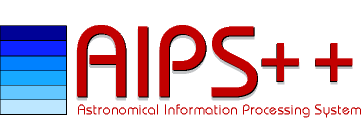
 News
News
| Getting Started | Documentation | Glish | Learn More | Programming | Contact Us |

| Version 1.9 Build 000 |
 News
News
|
natural weighting
NCSA
negative bowl artifact
Netscape
network
NEWSTAR
NFRA
NFS
non-closing offset
NRAO
NSF
NSFNet
nutation
Nyquist sampling rate
See uniform weighting.
National Center for Supercomputing Applications: a high-performance computing and communications facility and research center located at the University of Illinois in Urbana-Champaign. For details, consult the NCSA Home Page at http://www.ncsa.uiuc.edu/
See also Mosaic.
Netscape Communications Corporation are the developers of the Netscape Navigator browser for the World-Wide-Web. The browser is distributed free to academic and personal users, and is often itself colloquially termed "Netscape". For details about Netscape's browser (and other WWW tools) consult the Netscape Home Page at http://home.mcom.com/home/welcome.html
A hardware and software data communication system. Networks are often classified according to their geographical extent:
Networks may also be characterized according to the protocols used.
See for example Tanenbaum, A., Computer Networks, 2nd ed., Prentice Hall, Englewood Cliffs, NJ, 1989.
Netherlands East- West Synthesis Array Reduction. A software package for the reduction of radio interferometric data. NEWSTAR is designed and optimized for WSRT data, but can also handle data from other East-West arrays.
Netherlands Foundation for Research in Astronomy: a national facility supported by the Netherlands Organization for Scientific Research (NWO). It operates the WSRT and Dwingeloo radio telescopes. It participates in operating the JCMT and UKIRT facilities in Hawaii, and several optical telescopes on La Palma. It is also part of the AIPS++ consortium. For details, consult the NFRA Home Page at http://www.nfra.nl/.
Network File System: A protocol developed by Sun Microsystems, and defined in RFC 1094, which allows a computer to access files over a network as if they were on its local disks. This protocol has been incorporated in products by more than two hundred companies, and is now a de facto standard. NFS is implemented using a connectionless protocol (UDP) in order to make it stateless.
National Radio Astronomy Observatory: The U.S. national radio astronomy facility, managed by Associated Universities Inc., a university consortium, under a co-operative agreement with the National Science Foundation. The NRAO operates the GBT, VLA, VLBA and several smaller radio telescopes. For details, consult the NRAO Home Page at http://www.nrao.edu/
National Science Foundation: A U.S. (federal) government agency whose purpose is to promote the advancement of science. NSF funds science researchers, scientific projects, and infrastructure to improve the quality of scientific research. The NRAO and the NSFNet are funded by the NSF. For further details, consult the NSF Home Page at http://www.nsf.gov/
National Science Foundation Network: A high speed hierarchical "network of networks" in the U.S., funded by the National Science Foundation. At the highest level, it is a backbone network comprising 21 nodes connected to a 45Mb/s facility spanning the continental United States. Attached to that are mid-level networks and attached to the mid-levels are campus and local networks. NSFNET also connects out of the U.S. to Canada, Mexico, Europe, and the Pacific Rim. The NSFNET is part of the Internet.
1. In general, the variation with time of the Eulerian angle  that measures the angle between the
rotation axis of a spinning rigid body and a constant vertical
direction.
that measures the angle between the
rotation axis of a spinning rigid body and a constant vertical
direction.
2. In astronomy specifically, the irregular oscillation in the precessional motion of the earth's rotation axis, caused primarily by lunar perturbations. It has a principal period of 18.6 yr and moves the equinox as much as 17" ahead of, or behind, its mean position.
The slowest rate of sampling which, according to the Shannon sampling theorem, would allow a band-limited function f(t) to be recovered via the Shannon series. If the smallest symmetric interval which contains the support of the Fourier transform of f is the interval [-a,a], then the Nyquist sampling rate for f is 2a; i.e., the interval between samples (the sampling period) must be less than the reciprocal bandwidth 1/2a. The terms oversampling and undersampling refer to sampling at rates faster or slower than the Nyquist rate. The difference between f and the Shannon series formed from too coarsely spaced samples is called aliasing.
You could now go back to the:
Copyright © 1995,1999,2000 Associated Universities Inc., Washington, D.C.
abridle@nrao.edu, 16 August 1995, 17:19 EDT